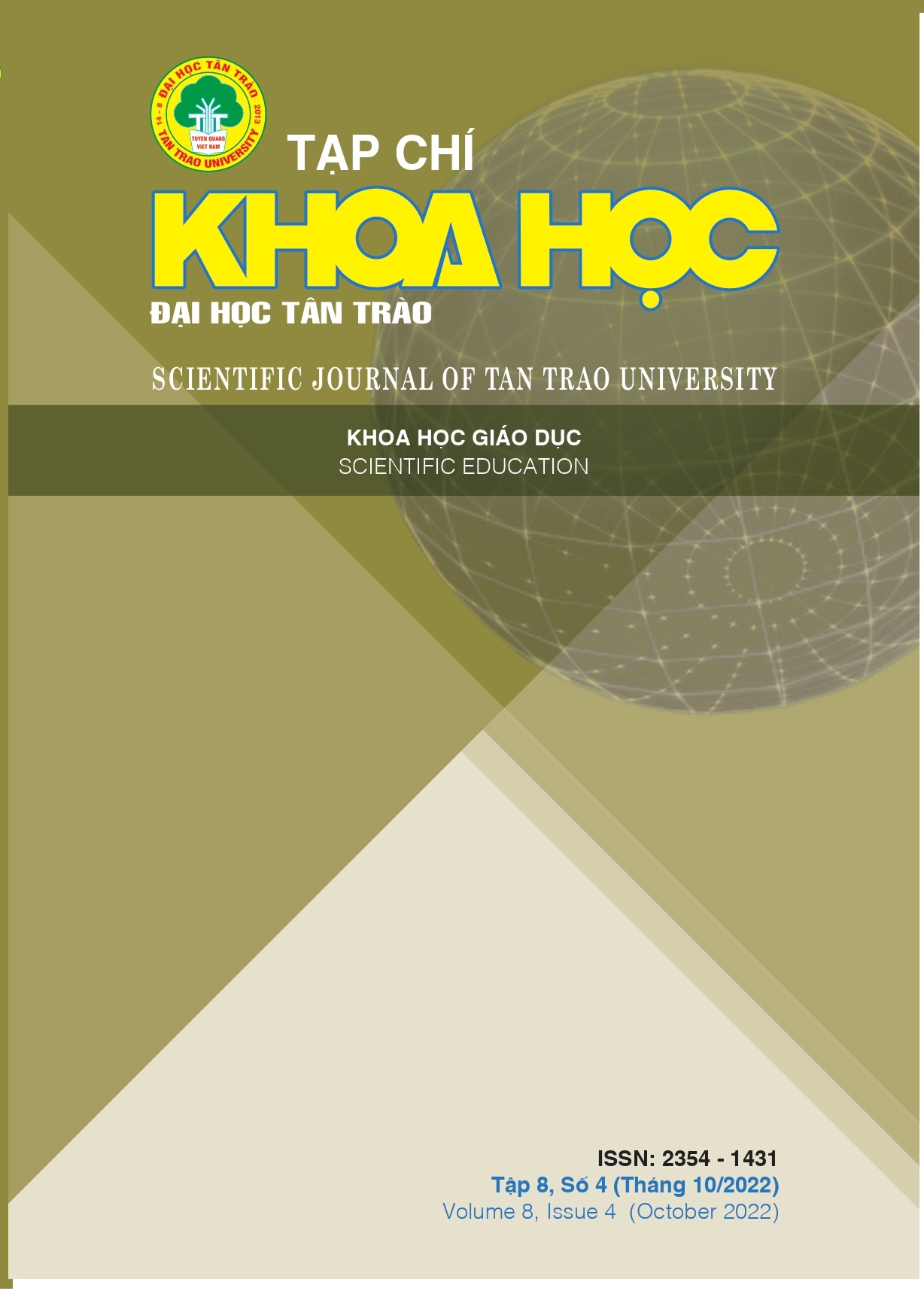SOME MEASURES TO IMPROVE VOCABULARY LEARNING STRATEGIES FOR NON-ENGLISH MAJOR STUDENTS
DOI:
https://doi.org/10.51453/2354-1431/2022/774Keywords:
dạy từ vựng, phương pháp ngữ dịch, sinh viên không chuyên, kỹ năng ngôn ngữ, cơ sở lý luậnAbstract
In the process of learning a foreign language, vocabulary can be considered
as the most important part because it is a means of expressing ideas and at the
same time it is a bridge to develop micro-language skills of listening, speaking,
reading and writing skills. However, the teaching of vocabulary has not
really been given much attention in the teaching process. With the traditional
method of teaching vocabulary, it is the Grammar-translation method, which is
commonly used in foreign language classes today. This paper uses the method
of analysis, summarizing experience to form the theoretical basis. The practical
investigation method using closed-ended questions with 5 levels of Likert is
applied to find out the current situation of vocabulary learning of non-English
major students. Based on the current situation, the study proposes measures
to improve the effective vocabulary learning for learners. The results of the
study contribute to teachers more useful reference information on how to teach
vocabulary to non-English major students. Students possibly understand the
necessary information for learning and developing their vocabulary through
the finding of this study..
Downloads
References
[1]. Ngo, T. T. H. (2022). The importance of learning vocabulary and some methods of teaching English vocabulary. Ho Chi Minh City Cadre Academy. [Online], Available: http://www.hocviencanbo.hochiminhcity.gov.vn/tam-quan-trong-cua-viec-hoc-tu-vung-va-mot-so-phuong-phap-giang-day-tu-vung-tieng-anh-ths-ngo-thi-thu-hien [Accessed Aug. 12th, 2022].
[2]. Wilkins, D. (1972). Linguistics in language teaching. London: Edward Arnold. Wong, W. & VanPatten, B. (2003). The evidence is in: drills are out. Foreign Language Annals. 36, 403 - 424. [Online], Available: https://doi.org/10.1111/j.1944-9720.2003.tb02123.x. [Accessed Aug. 12th, 2022].
[3]. Lewis, M. (1993). The lexical approach: The state of ELT and a way forward. Hove, UK: Language Teaching Publications.
[4]. Schmitt, N. (2010). Researching vocabulary: A vocabulary research manual. New York: Palgrave Macmillan.
[5]. Dinh, T. B. & Dao, T. C. (2019). Methods of teaching English vocabulary for students of Electricity University. Vietnam Journal of Education, 461(1), 46-50. [Online], Available: https://tapchigiaoduc.moet.gov.vn/vi/magazine/461-ki-i-thang-9/10-phuong-phap-day-hoc-tu-vung-tieng-anh-cho-sinh-vien-truong-dai-hoc-dien-luc-6985.html. [Accessed Aug. 12th, 2022].
[6]. Schmitt, N. (1997). Vocabulary learning strategies. In N. Schmitt & M. McCarthy (Eds.), Vocabulary: Description, acquisition and pedagogy (pp. 199 - 228). Cambridge: Cambridge University Press.
[7]. Ministry of Education and Training (2014). Circular promulgating the 6-level foreign language competency framework for Vietnam. No. 01/2014/TT-BGDĐT. https://vbpl.vn/bogiaoducdaotao/Pages/vbpq-van-ban-goc.aspx?ItemID=37680. [Accessed Aug. 12th, 2022].
[8]. Cronbach, L. J. (1951). Coefficient alpha and the internal structure of tests. Psychometrika, 16(3), 297 - 334. [Online], Available: https://doi.org/10.1007/bf02310555. [Accessed Aug. 12th, 2022].
[9]. Pham, M. L. (2022). An Investigation into English Vocabulary Learning Strategies Used by English Major Freshmen at a School of Thai Nguyen University. TNU Journal of Science and Technology, 227(04), 84 - 90. [Online], Available: https://doi.org/10.34238/tnu-jst.5506. [Accessed Aug. 12th, 2022].
[10]. Richards, J. C., & Rodgers, S. T. (2014). Approaches and Methods in Language Teaching (3rd). Cambridge University Press.
[11]. Schug, M. C. (2003). Teacher - Centred Instruction. The Rodney Dangerfield of Social Studies. In J. S. Leming, L. Ellington & K. Porter (Ed.), Where did social studies go wrong? (pp. 94 - 110). [Online], Available: http://www.lexiconic.net/pedagogy/TeacherCenteredSocialStudies.pdf. [Accessed Aug. 12th, 2022].
[12]. Rasouli, F., & Jafari, K. (2016). A Deeper Understanding of L2 Vocabulary Learning and Teaching: A Review Study. International Journal of Language and Linguistics, 4(1), 40 - 46. [Online], Available: https://doi.org/10.11648/j.ijll.20160401.16. [Accessed Aug. 12th, 2022].
[13]. Nguyen, T. T. N. (2022). An Investigation of Vocabulary Learning Strategies Used by Non-English Majors at Hong Duc University. Hong Duc University Journal of Science, 12(E2), 113 - 123. [Online], Available: https://vjol.info.vn/index.php/HDU/article/view/68060. [Accessed Aug. 12th, 2022].
[14]. Diaz, I. (2015). Training in metacognitive strategies for students’ vocabulary improvement by using learning journals. PROFILE Issues in Teachers’ Professional Development, 17(1), 87 - 102. [Online], Available: http://dx.doi.org/10.15446/profile.v17n1.41632. [Accessed Aug. 12th, 2022].
[15]. Nation, P. (2022). Teaching and learning vocabulary. In E. Hinkel (Ed.), Handbook of Practical Second Language Teaching and Learning. Routledge. [Online], Available: https://doi.org/10.4324/9781003106609. [Accessed Aug. 12th, 2022].
[16]. Webb, S. (2007). The effects of repetition on vocabulary knowledge. Applied Linguistics, 28(4), 46 - 65. [Online], Available: https://doi.org/10.1093/applin/aml048. [Accessed Aug. 12th, 2022].
Downloads
Published
How to Cite
Issue
Section
License

This work is licensed under a Creative Commons Attribution-ShareAlike 4.0 International License.
All articles published in SJTTU are licensed under a Creative Commons Attribution-ShareAlike 4.0 International (CC BY-SA) license. This means anyone is free to copy, transform, or redistribute articles for any lawful purpose in any medium, provided they give appropriate attribution to the original author(s) and SJTTU, link to the license, indicate if changes were made, and redistribute any derivative work under the same license.
Copyright on articles is retained by the respective author(s), without restrictions. A non-exclusive license is granted to SJTTU to publish the article and identify itself as its original publisher, along with the commercial right to include the article in a hardcopy issue for sale to libraries and individuals.
Although the conditions of the CC BY-SA license don't apply to authors (as the copyright holder of your article, you have no restrictions on your rights), by submitting to SJTTU, authors recognize the rights of readers, and must grant any third party the right to use their article to the extent provided by the license.


